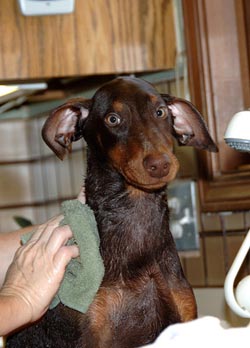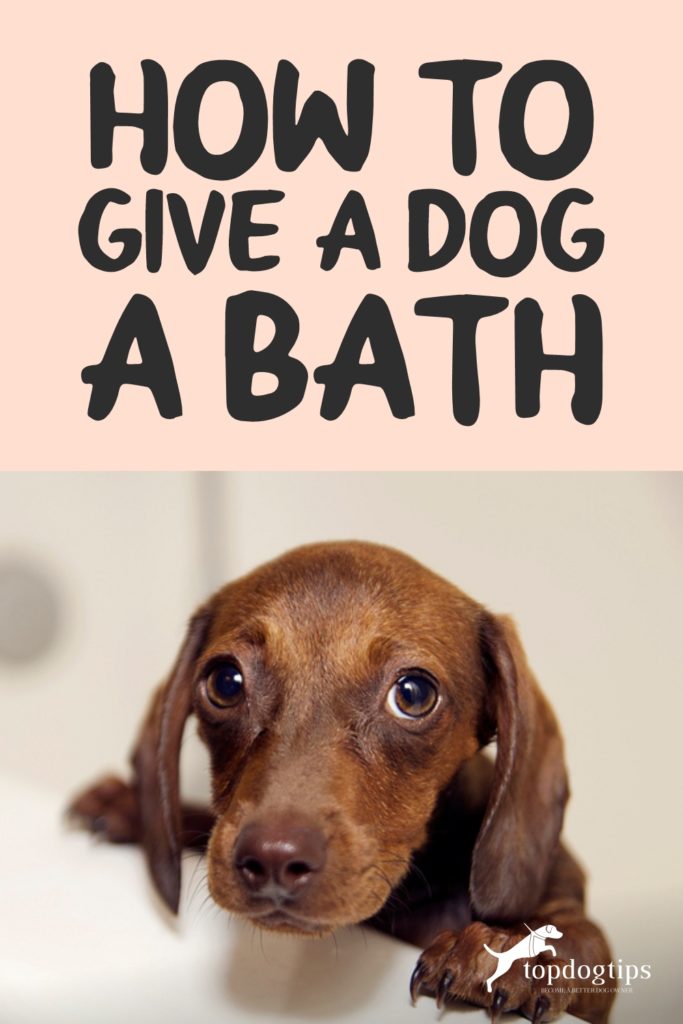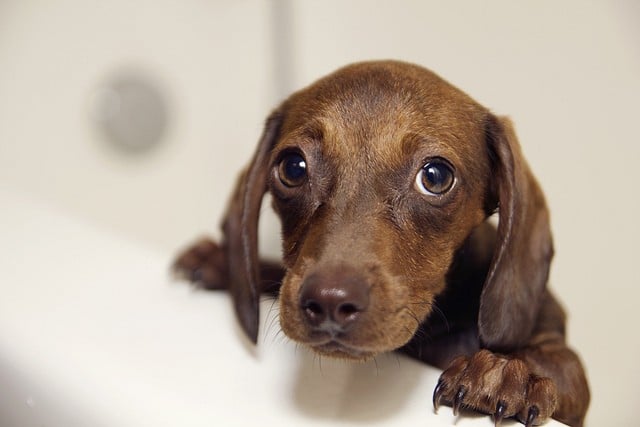
Table of Contents
Dog grooming is part of the deal after you decide to have a dog as your new family member.
Clipping nails, brushing hair, and bathing your dog should now be part of your weekly routine.
Sure, you can bring them to professional groomers every once in a while.
That is if you don't mind the cost!
As most dog owners know, canines are rarely excited about bathing.
Most dogs dislike getting wet, especially when they are forced into it.
But if you prefer doing it yourself, these tips that we're about to share with you should help you and your dog enjoy, and not dread, this process.
If these dog bathing tips aren't detailed enough, you can also educate yourself on the full process by reading some dog care literature!
Try our list of the best dog grooming books!
Also, remember to consider the place where you're going to bathe your dog and any dog grooming equipment that you'll need.
RELATED: How to Make Bathing a Dog Easier (And Some Unique Tools You Can Use)
Dog Bathing Tips: How to Give a Dog a Bath
Tip #1: Prepare to Bathe Your Dog
First, you must get yourself ready for the process.
Put on some clothes which you don't mind getting wet and possibly dirty as well as covered in dog hair.
Bring over all of your dog grooming equipment to wherever you are about to undertake this task—in your bathroom or, if the weather is good and you have a good dog washtub, outside.
Have your dog's shampoo and conditioner ready.
You can consult with the veterinarian about which dog shampoo to use, or you can also make your own homemade dog shampoo!
Conditioners are only necessary for dogs with really long coats which you must brush later (remember to have a dog brush handy, too).
Besides having some healthy dog treats with you (which you should always have on hand), there are other grooming things that aren't essential but can be helpful for the ultimate dog cleaning procedure:
- Cotton balls or Ear Cleanser to clean your dog's ears
- Puralube Vet Ointment for your pooch's eyes
- Really good Absorbent Dog Towel to dry your Fido quickly
If you're giving a dog a bath in your home in the bathroom, don't forget to lay some towels down on the floor—things might get messy.
Preferably though, try to get something that will not slide underneath your dog's feet, like a non-skid mat, like this high-grade one from PetFusion.
Note: If you don't have a detachable shower head, then try the technique with a large cup or some bowl that will help you rinse down the dog.
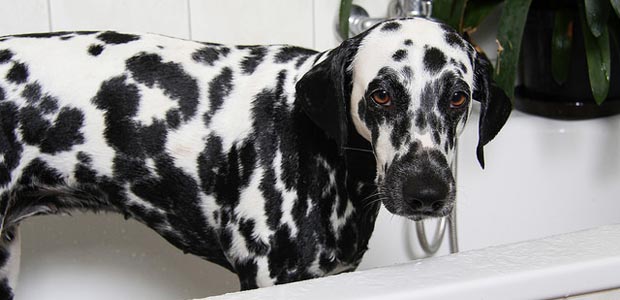
Tip #2: Get Your Dog Ready
The next step is to make sure your canine is prepared to be bathed.
There isn't much to do in terms of preparation in this regard, but trimming your pooch's nails wouldn't be the worst idea for two reasons:
- It will help your dog to have a stronger footing in the tub (or wherever you're washing them.)
- You will protect yourself from unnecessary damage in case your dog is going to break for it.
Now, it's time to take your dog to the bathroom.
If your canine is one of the many who dislikes being bathed, then this might become a challenge in itself with which you have to deal efficiently.
Even treats won't work most of the time if your Fido has already figured out what you want to do.
So find a way to get your dog in a washtub, and make sure to close the door behind you.
You really don't want a wet, soapy pet running around your home in case they escape somehow.
Then, once in the bathroom, give your pooch a dog treat.
Give him another treat as soon as he's in the bathtub.
A big part of good dog bathing tips practice is that positive reinforcement is necessary if you want to make sure that your future dog bathing adventures will have a more positive outcome and a less stressful process.
In fact, try offering your pets a treat even before they get into the tub and as soon as they enter the bathroom.
Note: To protect your dog's ears from the water, insert some cotton balls into their ears.
Be very gentle, and do not push too deep.
Don't forget to take them out when you're done giving a dog a bath.
You can also use mineral oil to protect your Fido's eyes from irritation because some dog shampoo will undoubtedly get into their eyes, which you probably won't notice (but your pet definitely will).
Tip #3: Get Your Dog Into the Tub
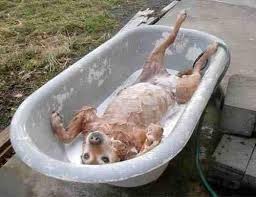
If your dog is a large breed, like a Newfoundland or a Great Dane big, you'll want to have at least a second person helping you with these dog bathing tips, especially if the pet is really caprice or passionately hates baths.
But before you somehow manage to get your dog into the actual bathtub, let the water run first and check that it has a good spring water temperature.
It should not be too hot and not be too cold.
Try to “introduce” your pooch to water gradually.
Have them hear the water running, then get them into the tub and let the dog touch a little bit of it.
The secret is to do everything slowly and gently, without sudden movements or hard force.
Never drop your dog into a tub and start spraying with water immediately.
This will only make your future bathing endeavors that much harder.
Even though you can overpower your canine, you're only doing yourself a disservice.
After you get your dog wet, it's time to introduce dog shampoo.
Start gently shampooing them from the shoulders and moving on from there all across the body.
Be very careful around the dog's face and any other areas that can be sensitive to them.
Just like bathing a child, it's important not to push too hard/
However, you need to make sure to get all the way to the undercoat, which often gets dirty over time.
For more specific details and directions on how to use the dog shampoo you have, read their labels.
Most of them have detailed step-by-step directions, anyway.
When you covered your pooch all over with shampoo, it's time to rinse it out.
Use your fingers and get right into the undercoat when doing so.
This will help to avoid subsequent irritation.
At this point, you can introduce your detachable shower head or, if you don't have it, try with a big cup or bowl.
Tip #4: Finishing It Off
The last step of dog bathing tips is after you rinsed out all the shampoo (and make sure that you really did!)
It's now time to use a little bit of conditioner for dogs with longer coats.
Again, check the bottle for a detailed step-by-step explanation of the best way to use that particular dog conditioner, like how much and how to apply it.
Remember, similarly to conditioners for people, they need to stay on the dog's hair for a few minutes to soak in actually to have an effect.
If your dogs are especially capricious and squirmy, you might need something that will work much quicker.
Keeping your dog in the tub for additional 2-3 minutes will not always be easy (and most dogs certainly won't enjoy the procedure either).
Once you followed the directions and rinsed out the conditioner, it's time to move on to the next dog bathing tips step.
Dry your wet pet very well.
You can use several very good absorbent home towels, but normally, it's recommended to purchase a special dog-drying towel (mentioned above) for those regular bathing ventures.
Those towels do wonders and will get most of the water out of your pet's coat significantly quicker than regular ones.
When towel drying of your dog is completed, for breeds with longer furs, it would be a good idea to use a blow dryer.
Another complicated matter, especially if your pooch is scared of the sound, but unfortunately, there's not much that can be done here besides using the lowest blow-strength setting.
After you've blow-dried your dog's coat, you can give them a really good brush.
If you're okay with hair everywhere around your house, then it's unnecessary to do this in the bathroom.
Because the dog is already dry, you can finish off the whole giving a dog a bath process outside of the “tainted” territory.
However, make sure to brush your canine's coat thoroughly, particularly if they have long and/or dense fur.
You can use a regular dog brush or combine it with a session of deshedding tools as well.
After your pooch is done with the bath, they might “go crazy” as most dogs do and start running around; let them do this, but prepare in advance.
If you know this will happen, don't let your pet out of the bathroom before everything on the dog bathing tips checklist is completed.
Otherwise, it will take you a while to bring them down and continue with the process.
Note: Bathing will loosen up a lot of fur on your dog, so when you brush their coat, there will be substantially more dog hair coming out than usual.
It's a good idea to consider this if you're worried about hair all over the house.
FAQs about Dog Bathing
Sure, here are some answers to the selected questions:
1. How often should I bathe my dog?
The frequency of baths for dogs depends on their breed, coat type, and lifestyle.
In general, most dogs only need to be bathed every 2-3 months or as needed if they get dirty or smelly.
Overbathing can strip the natural oils from your dog's skin and coat, which can lead to dryness and irritation.
2. How do I bathe a dog with a thick or double coat?
Bathing a dog with a thick or double coat can be challenging, as these coats can trap water and take a long time to dry.
It's important to use a high-quality shampoo that is designed for dogs with thick coats and to rinse thoroughly to prevent any shampoo residue from building up in the coat.
After bathing, use a high-velocity dryer or a towel to remove as much water as possible, and then allow your dog to air dry in a warm, dry area.
3. What should I do if my dog has skin allergies or sensitivities?
If your dog has skin allergies or sensitivities, it's important to use a hypoallergenic shampoo that is gentle on its skin.
You may also want to consult with your veterinarian to determine if there are any underlying health issues that may be contributing to your dog's skin problems.
4. Can I use human shampoo for bathing my dog?
No, you should not use human shampoo to bathe your dog.
Human shampoo is formulated for human hair and skin and can be too harsh for a dog's sensitive skin.
Instead, use a high-quality shampoo that is specifically designed for dogs.
5. What temperature should the water be when I bathe my dog?
The water should be lukewarm when you bathe your dog.
Water that is too hot can burn your dog's skin, while water that is too cold can be uncomfortable and make it harder to get your dog clean.
Test the water with your hand before bathing your dog to ensure that it is at the right temperature.
Dog Bathing Tips: Before You Go…
We hope these tips will help make bathing time easier and more enjoyable for you and your pooch!
If you're interested to read more about giving your dog a bath, check out our recommended articles below!
Related Articles:
- How To Dry A Dog After Bathing or Swimming
- How to Make Bathing a Dog Easier (And Some Unique Tools You Can Use)
- How to Get Your Dog to Love Bathing
Want To Share This…
Disclosure: We may earn affiliate commissions at no cost to you from the links on this page. This did not affect our assessment of products. Read more here and find full disclosure here.



